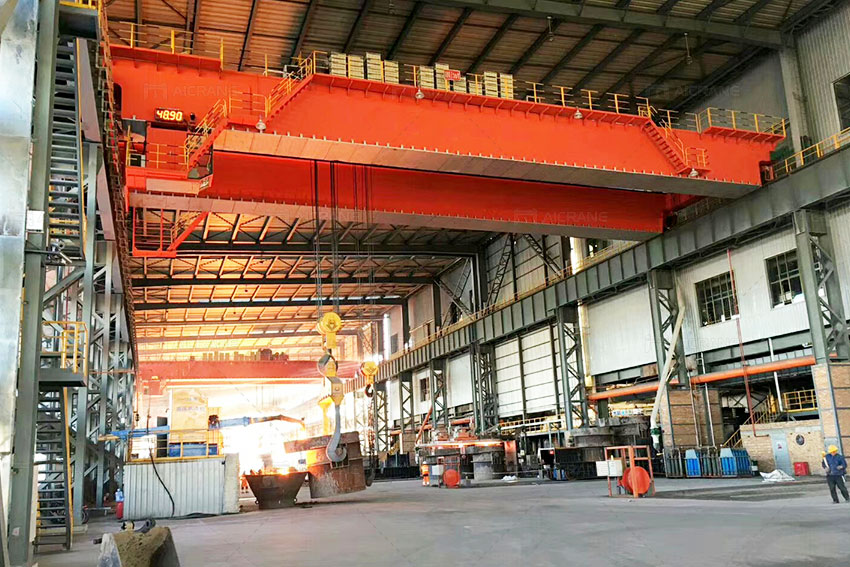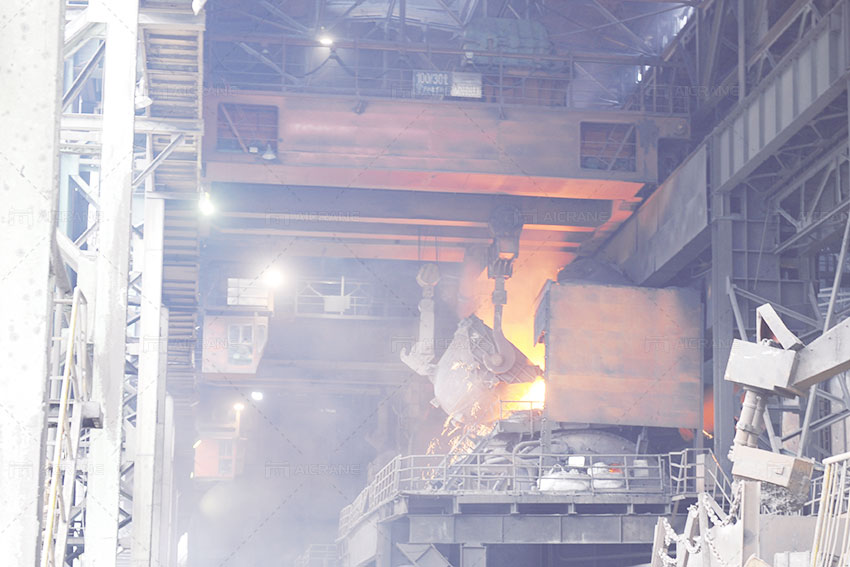Overhead cranes are vital pieces of equipment used in industrial facilities where heavy loads need to be moved. In steel mills and foundries, particularly, the lifting and handling of large, heavy, and often dangerous materials is a daily requirement. For this purpose, a 100-ton overhead crane is an ideal solution to ensure smooth, efficient, and safe operations.
In this article, we’ll explore the role of 100 ton overhead cranes in steel mills and foundries, their benefits, features, and best practices for selection and maintenance.

The Role of a 100-Ton Overhead Crane in Steel Mills and Foundries
Steel mills and foundries deal with some of the heaviest and most challenging materials, such as molten metal, large billets, steel coils, and heavy machinery parts. These materials need to be transported with precision, speed, and safety. A 100-ton overhead crane is specifically designed to handle these massive loads, making it an essential tool in these industries.
-
Lifting and Moving Heavy Loads: One of the primary roles of a 100-ton overhead crane is to lift and move extremely heavy steel and foundry products. Whether it’s moving raw materials to different parts of the mill or transferring finished products to storage areas, a crane of this capacity ensures these tasks are completed safely and efficiently.
-
Handling Molten Metal: Steel mills often work with molten metal, which is highly dangerous and requires precise handling. Overhead cranes equipped with specialized hooks, ladles, and other accessories can safely transport molten metal between furnaces, ladles, and casting stations, helping minimize the risk of accidents.
-
Load Positioning: In foundries, products often need to be positioned at specific angles for further processing. Overhead cranes offer precise control over load movement, ensuring that materials are safely and accurately positioned, which is crucial for effective production processes.
-
Maximizing Production Efficiency: Steel mills and foundries operate in fast-paced environments where productivity is paramount. A 100-ton steel mill crane can drastically reduce the time needed for material handling by offering fast, controlled lifts and precise load placements, allowing operators to focus on other important tasks.

Benefits of Using a 100-Ton Overhead Crane in Steel Mills and Foundries
1. Enhanced Safety
Safety is a top priority when working in heavy-duty environments like steel mills and foundries. A 100-ton overhead crane, with its advanced safety features such as overload protection, anti-collision systems, and emergency stop functions, ensures that operators and workers are protected from potential accidents.
2. Increased Productivity
The high lifting capacity of the crane allows for more material to be moved in less time, which directly translates into increased operational efficiency. The ability to move large quantities of material quickly reduces downtime and helps maintain consistent production levels.
3. Long Lifespan and Durability
Steel mills and foundries demand equipment that can withstand harsh conditions, including extreme temperatures, heavy loads, and constant use. 100-ton overhead cranes are built to endure these challenging conditions, ensuring they provide long-lasting service, reducing the need for frequent repairs or replacements.
4. Precise Load Control
In industries like steel production and metal casting, precision is key. 100-ton overhead cranes are equipped with advanced controls that allow operators to move loads with high precision, minimizing the risk of damage to expensive equipment or materials.
5. Customization Options
Overhead cranes can be tailored to meet the specific needs of each facility. For example, cranes used in steel mills and foundries might have specialized hooks, ladles, magnets, or tongs to handle specific materials, such as molten metal or steel billets.
Features of a 100-Ton Overhead Crane
A 100-ton overhead crane comes with a variety of advanced features designed to maximize its performance in industrial settings. Here are some common features that make these cranes an indispensable tool in steel mills and foundries:
-
High Lifting Capacity: As the name suggests, the foundry crane can handle loads up to 100 tons, ensuring it is suited for lifting and moving the heaviest materials found in steel mills and foundries.
-
Heavy Duty Hoist: The hoist system in a 100-ton overhead crane is designed for heavy-duty lifting. It can lift large and bulky materials like steel coils, ingots, and molds with ease.
-
Electric Control System: Modern overhead cranes are equipped with an electric control system that ensures smooth and efficient operation. This system also allows for better coordination, reducing the risk of human error and improving precision.
-
Anti-Sway Technology: In environments like steel mills, minimizing swing or sway when lifting heavy loads is critical. Overhead cranes are often equipped with anti-sway mechanisms that help keep the load stable, even when traveling over long distances.
-
Rugged Construction: Steel mills and foundries are tough environments. 100-ton cranes are built with heavy-duty steel, designed to resist the high-impact stresses they will encounter when lifting large materials.
Best Practices for Selecting and Maintaining a 100-Ton Overhead Crane
Selecting the Right Crane
When choosing a 100-ton overhead crane, it’s essential to consider several factors:
-
Load requirements: Ensure the crane is capable of handling the maximum weight of materials your facility needs to move.
-
Span and lifting height: Choose a crane that fits the operational space of your steel mill or foundry. The crane’s span and lifting height must be suitable for the layout of the facility.
-
Environment: Consider the working conditions, including temperature extremes and the presence of corrosive materials. Select a steel mill ladle crane designed to perform well under these conditions.
-
Automation needs: Modern cranes can be automated, which can improve efficiency and safety. Consider whether you need automation in your operations.
Maintenance
Proper maintenance is crucial for keeping a 100-ton overhead crane in optimal working condition. Regular checks should be performed on the following:
-
Hoist system: Check for wear and tear on cables and hoists to ensure they function smoothly.
-
Structural integrity: Inspect the crane for cracks, rust, or damage that could compromise its strength and safety.
-
Control system: Ensure the electrical system and remote control work flawlessly to prevent malfunctions during operation.
-
Lubrication: Regular lubrication of moving parts is essential to reduce friction and prevent premature wear.
Conclusion
A 100-ton overhead crane is a powerful and essential piece of equipment for steel mills and foundries. These cranes are specifically designed to handle the heavy loads, harsh environments, and precise control required in these industries. By selecting the right crane and adhering to best practices for maintenance, steel mills and foundries can maximize efficiency, improve safety, and ensure a longer lifespan for their cranes. With the right crane in place, companies can streamline operations, boost productivity, and enhance their overall competitiveness in the marketplace.